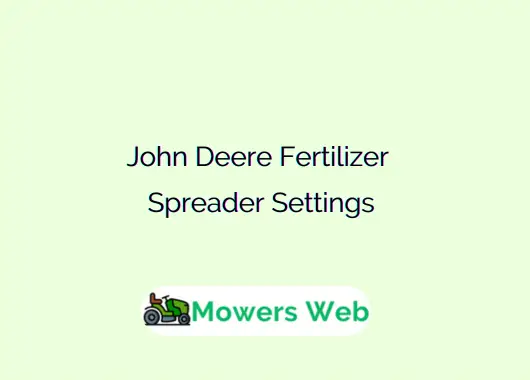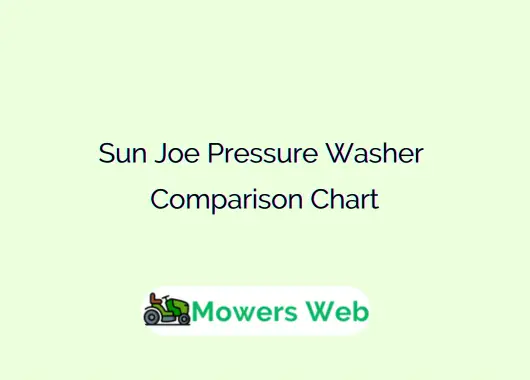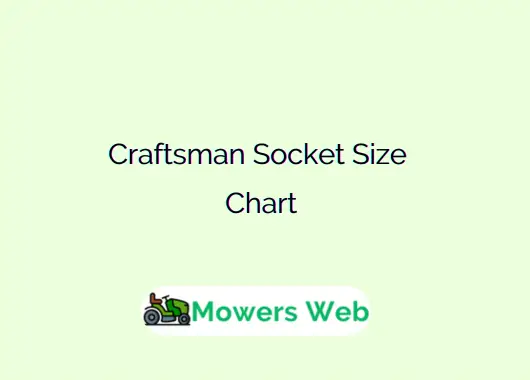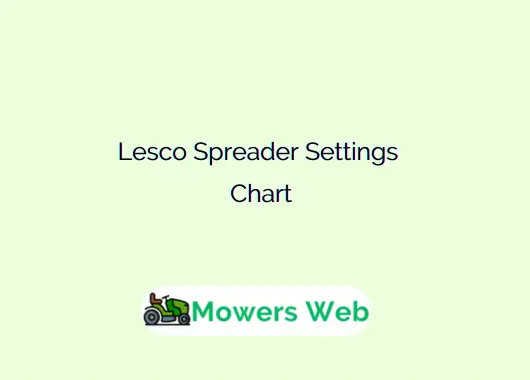Applying fertilizer correctly is key to achieving a healthy, uniform lawn or crop. When using a John Deere fertilizer spreader, proper settings ensure even distribution, prevent fertilizer burn, and avoid wasted product.
Each fertilizer type flows differently through the hopper, so understanding your spreader’s flow control settings is essential. These settings determine how wide the hopper gate opens, controlling how much fertilizer drops through during application.
John Deere Fertilizer Spreader Settings
| Fertilizer Type | Description | Suggested Flow Control Setting | Approximate Spread Width |
|---|---|---|---|
| All-Purpose Granular 10-10-10 | Balanced NPK for lawns and gardens | 4–5 | 8–10 ft |
| Nitrogen-Rich 30-0-4 | High-nitrogen turf fertilizer | 4–6 | 10–12 ft |
| Starter Fertilizer 12-24-10 | Encourages root development for new lawns | 3–4 | 8–10 ft |
| Slow-Release 16-4-8 | Extended feeding lawn fertilizer | 5–6 | 9–11 ft |
| Organic Pellet 5-5-0 | Natural fertilizer made from composted materials | 6–8 | 6–8 ft |
| Urea 46-0-0 | Fine granular nitrogen fertilizer | 3–5 | 8 ft |
| Lime Pellets | Used to correct soil pH | 6–8 | 10–12 ft |
| Potash (K) 0-0-60 | Supplies potassium for strong root systems | 4–6 | 8–10 ft |
| Ammonium Sulfate 21-0-0 | Fast-acting nitrogen fertilizer | 3–4 | 7–9 ft |
| Phosphate 0-46-0 | Promotes flower and fruit development | 4–5 | 8–10 ft |
| Weed-and-Feed Mix | Combined fertilizer and herbicide | 4–5 | 9–10 ft |
| Lawn Winterizer 24-0-10 | Fall and winter fertilizer blend | 5–6 | 10 ft |
| Fine Powder Fertilizer | Light, fast-flowing material | 3–4 | 3–4 ft |
| Heavy Coated Granular | Moisture-resistant coated granules | 6–7 | 10–12 ft |
| Organic Compost Blend | Lightweight, irregular material | 7–8 | 6–7 ft |
| Blood Meal 12-0-0 | Organic high-nitrogen fertilizer from dried blood, promotes leafy growth | 5–7 | 7–9 ft |
| Bone Meal 4-12-0 | Organic phosphorus source from ground bones, supports root and flower development | 4–6 | 8–10 ft |
| Fish Emulsion 5-1-1 | Liquid organic fertilizer from fish waste, provides balanced nutrients | 3–5 | 6–8 ft |
| Epsom Salt (Magnesium Sulfate) | Supplies magnesium and sulfur, corrects deficiencies in plants | 4–6 | 5–7 ft |
| Iron Chelate | Corrects iron deficiencies in plants, especially in alkaline soils | 3–4 | 4–6 ft |
| Superphosphate 0-20-0 | Concentrated phosphorus fertilizer for blooming plants | 4–5 | 8–10 ft |
| Kelp Meal 1-0-2 | Organic seaweed-based fertilizer, rich in trace minerals | 6–8 | 7–9 ft |
| Alfalfa Meal 2-0-1 | Organic fertilizer from alfalfa plants, adds nitrogen and stimulates soil microbes | 5–7 | 6–8 ft |
| Rock Phosphate 0-3-0 | Slow-release natural phosphorus source | 4–6 | 8–10 ft |
| Greensand 0-0-3 | Natural potassium and iron source from marine deposits | 5–7 | 9–11 ft |
Note: Settings are approximate starting points. Always verify with a calibration test.
Related John Deere Combine Settings Chart(Ultimate Guide)
How to Calibrate a John Deere Fertilizer Spreader
Calibration ensures you apply the right amount of fertilizer for your specific lawn or field conditions. Follow these steps:
- Start with an empty hopper. Set the flow-control dial to a low number to begin.
- Add a small amount of fertilizer. Use a consistent walking or driving speed, about 3 mph is standard for most spreaders.
- Test on a measured area. Spread fertilizer over a small section (e.g., 100 ft).
- Measure what you used. Compare it to your target application rate.
- Adjust the setting. If too much product is applied, lower the setting. If too little, increase it.
- Repeat the test. Continue adjusting until you reach the desired output.
- Apply in overlapping passes. Each pass should slightly overlap the previous one to prevent stripes and gaps.
Related Lesco Spreader Settings Chart(For All Product Types)
Tips for Accurate Fertilizer Application
1. Maintain Consistent Speed
Your walking or driving speed directly affects the application rate. Going faster increases spread width but reduces product per area. Slower speeds do the opposite. Try to maintain a steady 3 mph pace for even distribution.
2. Overlap Your Passes
Each pass of the spreader should overlap about 6–12 inches with the previous one. This prevents visible stripes and ensures full coverage.
3. Mind the Weather
Avoid spreading fertilizer on windy or rainy days. Wind will carry the granules off target, and rain can wash away nutrients before they absorb into the soil.
4. Check Fertilizer Moisture
Damp fertilizer clumps easily and won’t flow consistently. If you notice clumps, break them apart or dry the product before use.
5. Keep Records
Note the fertilizer type, spreader setting, and results each time you fertilize. Over time, you’ll build a personal reference chart that ensures consistent results every season.
6. Clean the Spreader After Use
Fertilizer residues can corrode the hopper and gate assembly. Rinse thoroughly with water after each use and dry completely before storage.
Related Yardworks Spreader Settings Chart(For All Product Types)
Example Application Scenario
Let’s walk through an example for a home lawn:
- Fertilizer: 10-10-10 All-Purpose Granular
- Desired Rate: 1 lb of nitrogen per 1,000 ft²
- Lawn Area: 5,000 ft²
- Product Needed: 50 lb of fertilizer (10% N × 10 lb per 1,000 ft² × 5)
- Spreader Setting: Start at “5”
- Spread Width: About 10 ft
First, fill the hopper halfway and make a test pass on a small section. Measure the amount applied, compare it to your target, and adjust the dial if necessary. Once you reach the desired rate, complete the full area in overlapping passes.
This same process applies to any fertilizer type, simply substitute the correct setting from the table.
Why Spreader Settings Differ
Each fertilizer behaves differently based on three physical properties:
- Particle Size – Smaller or lighter particles flow faster through the gate.
- Density – Heavier granules spread further and require a slightly larger opening.
- Moisture Content – Damp or sticky fertilizer flows slowly and may need a higher setting.
That’s why John Deere and most manufacturers recommend performing a field calibration each time you change fertilizer type, brand, or batch.
Related Scotts Spreader Settings Chart(For All Products & Types)
Common Mistakes to Avoid
- Skipping Calibration: Never rely solely on printed settings from a bag or old notes, recalibrate every season or whenever you switch fertilizers.
- Uneven Walking Speed: Sudden slowdowns or speeding up cause inconsistent application.
- Not Overlapping Passes: Leads to streaks or uneven growth patterns.
- Applying Before Rain: Nutrients can wash away, wasting fertilizer and harming the environment.
- Storing Fertilizer in the Hopper: Always empty leftover material after use to prevent corrosion or clogging.
Safety and Environmental Considerations
- Keep fertilizer off sidewalks, driveways, and streets. Sweep up spills immediately to prevent runoff into storm drains.
- Wear gloves and safety glasses when handling concentrated fertilizers.
- Store fertilizer in a dry, sealed container away from children and pets.
- Follow local regulations regarding fertilizer use near waterways or wells.
Proper handling not only protects your lawn but also safeguards the environment.
Final Thoughts
A well-calibrated John Deere fertilizer spreader can make the difference between a patchy lawn and a lush, evenly green surface. Start by using the recommended settings from the table above, then fine-tune through small test runs.
Remember, consistency is everything: maintain steady speed, overlap your passes, and adjust as you go.
Whether you’re using a standard broadcast spreader or a tow-behind model, these guidelines will help you apply fertilizer efficiently and safely every time.




